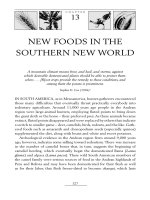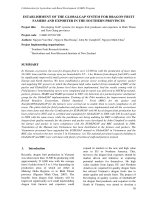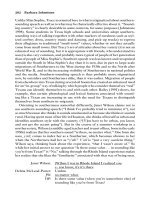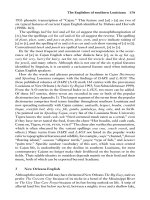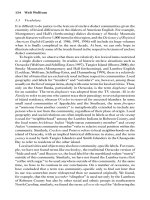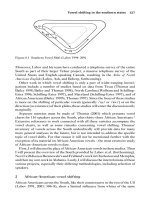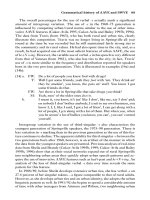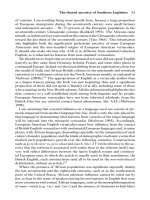NEW FOODS IN THE SOUTHERN NEW WORLD
Bạn đang xem bản rút gọn của tài liệu. Xem và tải ngay bản đầy đủ của tài liệu tại đây (199.78 KB, 8 trang )
127
CHAPTER
13
NEW FOODS IN THE
SOUTHERN NEW WORLD
A mountain climate means frost, and hail, and storms, against
which desirable domesticated plants should be able to protect them-
selves . . . [R]oot crops provide the remedy to those conditions, and
among them the potato is preeminent.
Sophia D. Coe (1994)
1
IN SOUTH AMERICA, as in Mesoamerica, hunter-gatherers encountered
those many diffi culties that eventually thrust practically everybody into
sedentary agriculture. Around 11,000 years ago people in the Andean
region were large-animal hunters, employing fl uted points to bring down
the giant sloth or the horse – their preferred prey. As these animals became
extinct, fl uted points disappeared and were replaced by others that indicate
a switch to smaller game – deer, camelids, birds, rodents, and the like. Gath-
ered foods such as amaranth and chenopodium seeds (especially quinoa)
supplemented the diet, along with beans and white and sweet potatoes.
Archeological evidence in the Andean region from around 9,000 years
ago, however, indicates some sidling toward sedentism. There was increase
in the number of camelid bones that, in turn, suggests the beginning of
camelid herding, which eventually begat the domesticated llama ( Lama
glama) and alpaca ( Lama pacos). These wild South American members of
the camel family were serious sources of food in the Andean highlands of
Peru and Bolivia and may have been domesticated for their fl esh as well
as for their labor, that fl esh freeze-dried to become charqui, which lasts
128
A Movable Feast
indefi nitely. Native Americans who kept llamas and alpacas did not milk
them, however, which meant they passed up a good source of protein. Lac-
tose intolerance is often the explanation offered but even the lactose intol-
erant can consume milk products such as cheese or yogurt in moderation.
2
Guinea pigs ( Cavia porcellus) were trapped and eventually became
domesticates as did Muscovy ducks ( Cairina moschata). Muscovy is a mis-
nomer for this tropical American duck, which has no special association
with Moscow, but is a duck that can mate and produce offspring with the
common duck ( Anas platyrhaynchos), even though the offspring are not
able to reproduce. By the time of the conquest, the Muscovy duck could
be found from Argentina to Mexico and the Caribbean, and although the
turkey was a fowl competitor in Mexico, it had no such competition in
South America.
3
Unlike the common duck, wild Muscovies roost in trees, although their
truly domesticated counterparts cannot fl y. In the Americas the birds were
kept for their fl esh, their eggs, and especially for their badly needed fat.
Like so many other American foods, Muscovy ducks also wound up in
sixteenth-century Europe although the names they acquired like “Turkish”
duck in Germany, bird from the “Barbary Coast” in France, or Muscovy
for that matter, show near-total confusion about the bird’s origin. It was in
France, that the Muscovy and the common duck were crossed to produce
the mulard duck, whose hypertrophied livers are, along with goose livers,
the makings of pâté de foie gras.
4
Plant foods overshadowed the few domesticated animals of the Andean
region by a considerable margin. In fact, there were more than fi fty South
American plants domesticated by pre-Columbian peoples and four of these –
white potatoes, sweet potatoes, manioc, and peanuts – today rank among the
world’s most valued crops.
5
In the Andes, where mountain climates at the
higher altitudes can spell disaster for above-ground crops, it is not surprising
that underground crops such as potatoes were highly valued.
White potatoes ( Solanum tuberosum), the fourth most important of the
world’s food crops today and the major highland crop of the Andes, were
probably domesticated in the neighborhood of Lake Titicaca at least 5,000
years ago (although the Chilean lowlands also claim a potato sub-species).
Icy temperatures at night, alternating with the heat of the day, made it
possible to freeze-dry them for storage, an ingenious process of freezing,
soaking, and drying used to make chuño, a processed food that would keep
well for several years.
6
New Foods in the Southern New World
129
The Pizarro expedition reached Peru to fi nd
potato (initially they thought it a white truffl e)
cultivation widespread throughout the Andean
region, along with what might be termed a
“potato culture.” The Aymara people, for
example, calculated time in terms of how long
it took to boil a potato.
7
Curiously, however, at
the time of the conquest white potatoes, unlike
sweet potatoes and maize, were not widely dispersed
elsewhere in the Americas and, in fact, even after the conquest they were
slow to move about despite the wide range in which they can grow, and
despite their health-giving properties.
Of the world’s major staples – potatoes, corn, rice, and wheat – the
potato provides by far the most nutrients and the most meals per acre. It
also delivers variety, although North Americans, with only eight varieties
of potatoes readily available to them, might not think so. But in Peru there
are countless kinds – breakfast potatoes, luncheon potatoes, supper pota-
toes, dessert potatoes – all with different colors, shapes, and tastes.
The sweet potato ( Ipomoea batatas) by most reports was domesti cated in
Peru at about the same time as the white potato, although remains of what
may have been a domesticated sweet potato have been
dated to around 10,000 years ago.
8
If they were a
domesticated plant at that point, sweet potatoes
would rank among the very fi rst food crops to
be cultivated anywhere in the world. Such an
antiquity may be hinted at by the more than
150 varieties of sweet potatoes that were under
cultivation when the Spaniards fi rst reached the
Andean region. But the antiquity of its domestication
is by no means the only controversy this mysterious plant
has sparked. As we discuss in Chapter 13, sweet pota-
toes are also suspected of somehow fi nding their way to
Australia, New Zealand, and many of the Pacifi c Islands
long before the Europeans reached the Americas – let
alone remote (for them) Oceania.
9
Oca or occa ( Oxalis tuberosa) a root crop second only
to potatoes in the Andes, has the virtue of growing
at altitudes where potatoes will not. The Oxalis
130
A Movable Feast
part of its scientifi c name means “acid” in Greek but, fortunately, the acidic
taste of its tubers vanishes after a few days of sun-drying. Oca only became
one of the globe-trotting Andean plants in the nineteenth century, when it
was taken to Europe to supplement the potato. This did not prove success-
ful but oca next moved on to New Zealand, where it did catch on. Today
it is commercially cultivated as the “New Zealand yam.”
10
Arracacha ( Arracacia xanthorrhiza), apparently domesticated before the
potato, is another Andean staple. Although related to celery, parsnips, and
carrots, it is the only member of this family with a New World pedigree.
Sometimes called the “Peruvian carrot,” it grows carrot-like roots that replace
the potato in some mountainous areas because it costs less to plant and har-
vest. At one time or another arracacha spread throughout Latin America as
far north as Costa Rica, and to Cuba and Haiti in the Caribbean.
11
Other plants also migrated within the Americas. Sweet potatoes, as
already mentioned, were in the Caribbean and were a Maya comestible
when Columbus arrived. Evidence indicates that although maize is of
greatest antiquity in Mesoamerica, it reached Ecuador by both land and
sea routes. In fact, if maize was slow to move northward out of Meso-
america it moved in the other direction like lightening, reaching the Andes
as early as 6000
BCE
, where it must have been subjected to those breeding
trials and errors that, as in Mexico, gradually increased the size of the ear
and made the plant more adaptable.
On the south coast of Ecuador, peoples who had previously been hunt-
ers, fi shers, and gatherers began to specialize in growing the grain. By about
1,000
BCE
, maize cultivation had spread into the Amazon region and to the
Orinoco fl oodplains to stimulate the growth of populations and the con-
comitant development of stratifi ed societies.
12
Later, maize was a favored
foodstuff of the Incas, who used it in a variety of ways, not the least of
which was to mass-produce a beer they called chicha.
13
After maize, the preferred grain of the Andean region was quinoa ( Che-
nopodium quinoa) – a high altitude plant of the goosefoot or pigweed family
that today is planted from Columbia to Chile and Argentina. Its seeds are
toasted and made into a porridge. But, although delicious and nutritious
(with an average protein yield higher than that of wheat and a better array
of essential amino acids), quinoa, unlike maize, has never traveled outside
of its American homeland.
14
A relative of quinoa, cañihua ( Chenopodium
pallidicaule), raised in the mountains of southern Peru and Bolivia, is used
much like quinoa and, because it is tolerant of frost and dry soils, does
New Foods in the Southern New World
131
better at even higher altitudes. Also known as
quañiwa and cañahua, botanists believe that its
domestication is not yet complete.
15
Getting back to underground crops, although
there is evidence of the peanut being grown in
Peru some 3,000 to 4,000 years ago, the plant
is believed to have been fi rst domesticated in
that region where modern-day Paraguay borders
with southwestern Brazil. Not a nut at all, but a tropical
legume that develops underground (hence the name “groundnut”), the pea-
nut had done considerable diffusing by the time of the Columbian voyages,
so that it was being cultivated in Hispaniola when the explorer came ashore.
The Spanish and Portuguese subsequently introduced peanuts to all of the
world’s tropics.
16
Manioc (from manihot in the Tupi language of Brazil) is also known as
“cassava,” (from the Arawak kasibi), and “yucca,” (from the Carib Indian
word), and may have initially been domesticated in central Brazil. How-
ever, other likely possibilities are the lowland tropical forests of Ecuador,
Venezuela, and Columbia. The Caribbean islands and Central America,
too, have been put forward as candidates.
Manioc is a perennial plant grown mostly for its starchy roots that weigh
from a pound or two to over six pounds, although young shoots and leaves
are also edible. Manioc griddles dating from approximately 4,000 to 2,000
years ago have been found at sites along the Orinoco river – fi nds that
do not necessarily dispute those who believe that manioc domestication
took place as many as 7,000 years ago. Generally thought of as a lowland
tropical crop, manioc was suffi ciently adaptable to achieve important food
status in the Andean region, where it was grown in valleys as high as 6,000
feet above sea level.
Manioc defi es drought and insects and its cyanide content discourages
root-digging animals, but not human animals who somehow discovered
how to render its tubers edible. It was a complex process of removing
the poison by heating, scraping, and leaching that made this tuber a sta-
ple throughout much of South and Central America and, of course, the
Caribbean.
17
It was on the day after Christmas in 1492 that a local chief
treated Columbus to a manioc feast on Hispaniola,
18
and in his log the
explorer (who thought the tubers were a kind of turnip) provided a partial
description of manioc preparation: “They shred those turnips on certain
